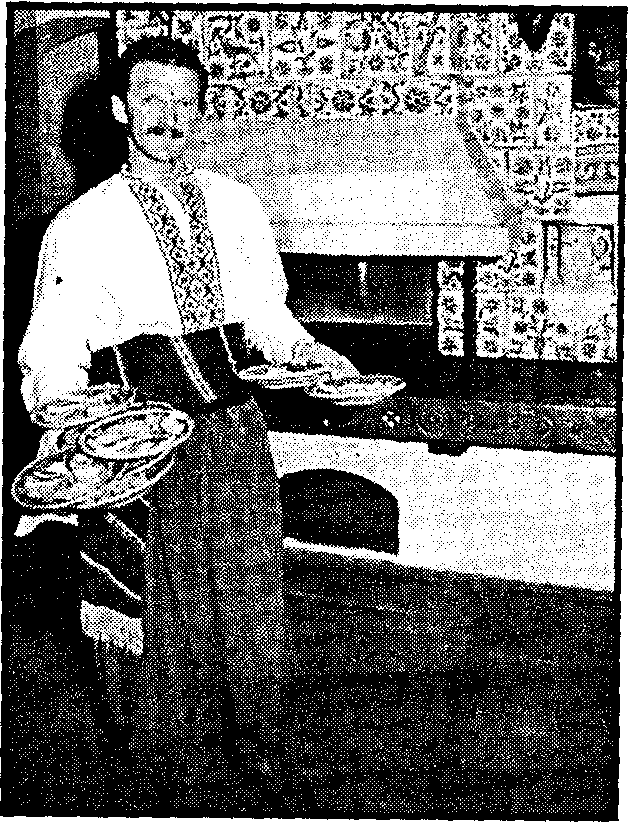
Unit II ukrainian way of life traditional food
Appetite comes with eating.
Ukrainian proverb.
Ukrainian cuisine is varied and rich in taste and nutritional value. Its development was influenced by the same factors as the development of material culture: geography and climatic conditions, plant cultivation and animal domestication, technological change, cultural influences, and economic relations with other countries.
Since
ancient times Ukrainians have practiced a settled form of life based
on farming. Archeological evidence shows that wheat, barley, and
millet were grown in Ukraine 3,000 years ago. Rye was introduced,
about 2,000
years ago, and then buckwheat was imported from Asia in the 11th
century AD. Already at that time cattle, sheep, hogs and poultry were
raised. 
As a result of Ukraine's trade relations with other countries, the cultivation of new plants, particularly from eastern and central Asia (e.g. melons and eggplants), was introduced into Ukraine. The potato reached Ukraine from America through Europe in the 17th century, followed by corn, tomatoes, pumpkins, beans, cayenne, peppers, cocoa, and other plants. The introduction of these new products greatly enriched the variety of Ukrainian foods.
Since ancient times bread has held a special, primary position in the cuisine of the Ukrainian people. In general sour rye bread is the common type of bread produced in Ukraine, except in the southern and southeastern regions, where white-wheat bread is more common. Besides ordinary bread Ukrainians bake various ritual breads from special doughs. Ukrainian bread with its many variations has become quite famous.
Cooked cereal—whether wheat, barley, buckwheat, millet, oat, or corn grits—is an ancient Ukrainian food. The most commonly eaten cereals are buckwheat (kasha), millet, and, in the Hutsul and Transcarpathian regions, cornmeal (mamalyga or kulesha).
The favorite dishes made of flour are dumplings (halushky) and filled dumplings (varenyky) with various types of filling: cheese, potato and cheese, cabbage, meat, fish, buckwheat.
The
potato is most widely used vegetable in Ukrainian cooking. It is a
necessary ingredient in all soups, particularly borsch and cabbage
soup. Boiled or baked potatoes are served alone or with meat, fish,
cheese, cabbage, mushrooms and so on. Another important element in
Ukrainian cooking is cabbage. Cabbage leaves are used in making
cabbage rolls (holubtsi),
which are filled
with buckwheat or millet grits, rice or meat. Other vegetables such
as onions, garlic, carrots, turnips, radishes, and cucumbers are
frequently eaten raw. 
In the Ukrainian tradition a soup or borsch must be served with dinner. Various soups—made with meat, fish, vegetables, fruit, or milk—are popular, but borsch remains the favorite. It is made of vegetables, among which beets and cabbage are predominant, and meat or fish.
Meat is usually eaten on feast days, Sundays, or at family celebrations. The most popular meat is pork and its products, such as ham, sausage, blood sausage, smoked bacon and salt pork.
Foods prepared with milk, dairy products and eggs have long been a part of Ukrainian cooking. Soured milk is a favorite drink throughout Ukraine. Cottage cheese is eaten mixed with sour cream. A salty cheese from sheep's milk (brynza) is made in the Hutsul region and Bukovyna.
Bread kvas, fruit or cucumber broth, and birch sap are popular folk beverages in Ukraine. Tea is the most widely consumed hot beverage, followed by coffee and cocoa. Alcoholic beverages such as mead, wine, fruit liqueurs (nalyvka), alcohol with pepper and beer have been popular for many centuries.
There are significant regional variations in Ukrainian cuisine that resulted from the availability of different agricultural products, foreign influences, or even the conservatism of the common people in regard to change.
HOLIDAYS
Like most European nations Ukraine sees the New Year on December 31. You can hardly find a person who doesn't hope that the Old Year with all its troubles will leave forever and the New Year will bring health, prosperity and happiness. On New Year's Eve most people decorate a New Year tree with garlands, toys and sweets, prepare presents for their near and dear and enjoy the all-night New Year parties. January 1 is an official day off, but nowadays many businesses close for several days till January 8 or 10 to give their employees New Year and Christmas holidays.
New Year celebrations gradually glide into one of the most important religious holidays — Christmas. For many years this holiday was observed only by religious people, but now it is an official state holiday and a day off. It is favourite with children who like to go from door to door, sing carols and get sweets from the hosts. Mothers of the family cook a traditional Ukrainian Christmas dish "kutya" which all the family eat together. Many people now like to go to church to listen to Christmas sermons.
Not long ago young people and lovers of all ages started to follow the English tradition of celebrating St. Valentine's Day on February 14 by sending special postcards and giving lovely gifts to their sweethearts. It is especially popular with schoolchildren who have little wish to study on this day.
The next official holiday in Ukrainian calendar is Women's Day. Very few people remember now how it originated, but it is an important signpost in the women's feminist movement in the world, because it commemorates the beginning of women's struggle for their economic, political and social rights. Today, it is the day to show love and respect to women of all ages, when most Ukrainian fathers, husbands and sons clean and cook and give wonderful presents and flowers to their beautiful wives, mothers and daughters. Many women regret that this day comes only once a year.
April Fools' Day is not an official holiday in Ukraine but it is very popular in this country. It was borrowed from Britain long ago and since then has been enjoyed by the young and the old. It is one of the most favourite holidays with school children, students and humourists who turned it into the "National Day of Humour".
By
Orthodox canons Easter, the day of Christ's Resurrection, is
celebrated in Ukraine later than in other European countries. Only
several years ago it was proclaimed an official state holiday and
many people celebrate it by attending the all-night service in church
and having a tasty meal at home on Red Sunday. Children enjoy
painting Easter eggs and eating raster bread.
May holidays begin on the first day of this month as a holiday of spring and peace. For many years in the former Soviet Union it was celebrated as an official state holiday— Labour Day. Now it has lost its political significance and people just enjoy additional days off either having a rest in the open air or working in their gardens.
Victory Day, which is annually marked on May 9, commemorates the victory of Soviet people over Nazi Germany in 1945. So many people died or were killed in that war that there is hardly a family in Ukraine that didn't suffer a loss. On this day many people go to military cemeteries and memorials to take flowers to the monuments and show their respect and appreciation to those who defended their Motherland by the cost of their lives.
The new Constitution of Ukraine as an independent, sovereign, democratic, social and legal state was adopted by the Verkhovna Rada on June 28,1996 as the Fundamental Law of the country. The day of its adoption is a state holiday—the Day of the Constitution of Ukraine.
August 24 is a new national state holiday-the Day of Independence of Ukraine, which was proclaimed in 1991 on the decision of the Verkhovna Rada of Ukraine after the military coup in Moscow. This day is marked with parades and fireworks.
A traditional holiday on November 7 commemorates an important historic event — the Great October Socialist Revolution that took place in 1917 and influenced the life of people not only in our country but in most countries of the world. This state holiday used to be marked with military parades and peaceful demonstrations, but now most people regard it as a good chance to have a rest and a family get-together.
Most Ukrainian people enjoy holidays both old and new because they are good breaks in everyday work, an opportunity to see their friends and relatives and just to have a good time.
